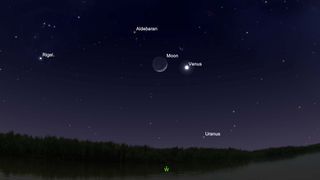See Venus swing by the crescent moon this weekend
Here's where to look.

The "evening star" Venus will meet up with the waxing, crescent moon in the night sky this weekend. You can spot the celestial pair above the western horizon after sunset.
Related: Moon phases
On Saturday (March 28), the moon and Venus will be in conjunction — meaning they share the same celestial longitude and will appear close together — at 6:37 a.m. EDT (1037 GMT), according to the skywatching site In-The-Sky.org.
For skywatchers in the United States, the conjunction occurs when both Venus and the moon are below the horizon, so the closest approach won't be visible. However, they'll be pretty close together on the nights before and after the conjunction.
Related: Venus and moon share spectacular close encounter (photos)

While both Venus will be in the constellation of Aries, the ram on Friday (March 27), the moon will move along into its neighboring constellation of Taurus, the bull, come Saturday night.
Also visible nearby is the bright star Aldebaran, also known as the "eye" of Taurus, the bull. You may even be able to see the planet Uranus closer to the horizon, but only if you have a dark sky and binoculars or a telescope.
Get the Space.com Newsletter
Breaking space news, the latest updates on rocket launches, skywatching events and more!
Editor's note: If you have an amazing skywatching photo you'd like to share for a possible story or image gallery, you can send images and comments in to spacephotos@futurenet.com.
- What is a 'morning star,' and what is an 'evening star'?
- When, where and how to see the planets in the 2020 night sky
- See the Spring Diamond shine in the night sky
Email Hanneke Weitering at hweitering@space.com or follow her @hannekescience. Follow us on Twitter @Spacedotcom and on Facebook.
OFFER: Save at least 56% with our latest magazine deal!
All About Space magazine takes you on an awe-inspiring journey through our solar system and beyond, from the amazing technology and spacecraft that enables humanity to venture into orbit, to the complexities of space science.
Join our Space Forums to keep talking space on the latest missions, night sky and more! And if you have a news tip, correction or comment, let us know at: community@space.com.

Hanneke Weitering is a multimedia journalist in the Pacific Northwest reporting on the future of aviation at FutureFlight.aero and Aviation International News and was previously the Editor for Spaceflight and Astronomy news here at Space.com. As an editor with over 10 years of experience in science journalism she has previously written for Scholastic Classroom Magazines, MedPage Today and The Joint Institute for Computational Sciences at Oak Ridge National Laboratory. After studying physics at the University of Tennessee in her hometown of Knoxville, she earned her graduate degree in Science, Health and Environmental Reporting (SHERP) from New York University. Hanneke joined the Space.com team in 2016 as a staff writer and producer, covering topics including spaceflight and astronomy. She currently lives in Seattle, home of the Space Needle, with her cat and two snakes. In her spare time, Hanneke enjoys exploring the Rocky Mountains, basking in nature and looking for dark skies to gaze at the cosmos.
-
rod ReplyAdmin said:The "evening star" Venus will meet up with the waxing, crescent moon in the night sky this weekend. You can spot the celestial pair above the western horizon after sunset.
See Venus swing by the crescent moon this weekend : Read more
Venus is putting on a show. Since the beginning of this year, I viewed Venus 10x using my telescopes through this month, 90-mm size and 10-inch ranging 31x to 200x views and using blue filter too. The planet is putting on the heliocentric solar system show in the eyepiece (angular size increasing, brightness level increasing, phase changes :) At times, some hint of cloud bands visible near the terminator and equator area using the filter. -
Heaven Venus is currently in a brilliantly bright apparition as we seen from earth so i really guess the venus is putting on a show with the moon venus will reach it's brightest and best of 2020 early in may before disappearing into dawn in the sky in june it'll become a brilliant “morning star” in half of 2020Reply

